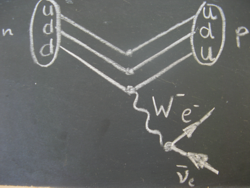W boson and radioactivity at the elementary particle level
By looking deep inside the atoms, all the way down to the elementary particle level, one can explain radioactive decay by the mediation of a charged W boson. When a proton (electric charge +1) is transformed into a neutron (electric charge 0) or vice-versa, this is what is really happening: a u-quark from a proton (=uud) emits a W+ and becomes a d-quark, the proton becoming thereby a neutron (=udd), followed by a W+ decay into a positron (e+) and a neutrino (νe). In the other radioactive process where a neutron is transformed to a proton, it is a d-quark that is changed to a u-quark by W- emission, followed by the decay of the W-into an electron (e-) and an antineutrino νe.
We can illustrate this process with a so-called Feynman diagram, which you will be better acquainted with later in the Z path. A Feynman diagram illustrates particle physics processes. A straight line represents a matter particle, a wiggly line a force carrier particle, and a vertex represents a transformation. You can think of time going from left to right.
For further information about the role of the W particle follow the W path.
